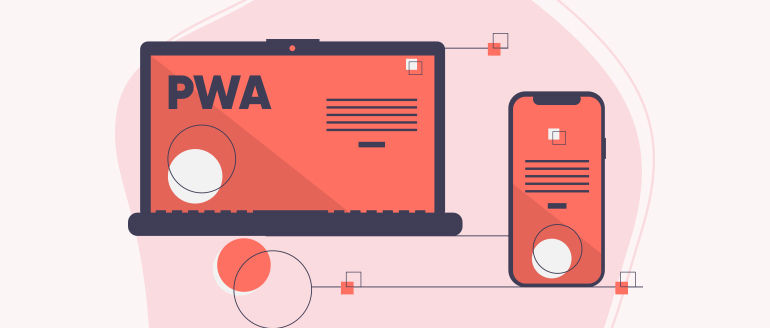What Does PWA Mean?

What is a progressive web app? It is a progressive technology in web development that helps to build a website visually and functionally resembling a mobile application, only it is displayed in a browser.
PWAs are built using Python, ReactJS, Kubernetes, Django, NestJs, PostgreSQL, WebSockets: iOS (Swift), and Android (Java, Kotlin) stack. Advanced functionality allows to add a site or a separate page to the screen of any device, as well as send push notifications.
A progressive web application allows an application site to work offline. A good progressive web app example is Google Docs – even it was built for online working, you can also use it offline.
PWA Apps Positive Features

Every business owner today strives to be the best represented in the digital world, providing an interesting and convenient product for both desktop users and mobile audiences. Alternatively, many choose to create a mobile application. However, the task of high-end web development companies is to offer alternatives to any ideas.
The benefit of the PWA is obvious: you do not have to spend money and time to create a separate application. Also, we want to highlight the next benefits:
- Compatible with almost all mobile devices
- Run faster than regular applications
- PWAs can work autonomously, without an Internet connection
- Instantly downloaded to the device
- Occupy little space
- Easy to use
Owlab.group highly supports such web development. We believe, that such apps are the future that we’ll have in the nearest time. So we suggest you create a progressive web application for your business today.
PWA Apps Negative Features

With a large number of advantages, there are only a few disadvantages that can be eliminated in the future:
- It cannot send notifications on iOS if the Safari browser is selected by default. But starting with iOS14, a user can pick a default browser, so the users can switch browsers to receive notifications. At the moment, the technology works great with Chrome, Edge, and Firefox browsers, which are about 80% of the market.
- The apps have Bluetooth limitations and do not support Touch ID.
Some Examples
There are plenty of experience and progressive web apps examples that help to understand better. You’ve probably seen the following ones:
- Tinder sped up page load time. It takes up 90% less space than a native app
- Walmart. The online store increased traffic by 28% after the launch. This surely influenced the website’s overall performance and conversion.
- The Washington Post. The number of visits increased by 12% and the page load time decreased to 80 milliseconds after the launch.
- Book My Show. India's largest ticketing company with 50 million monthly visitors. New product implementation increased conversions by 80%.
Among others, we can also highlight Alibaba, Forbes, and The Weather Channel.
And one of the most important questions. Which online business will benefit from the PWA technology?
- Online stores
- Info resources
- Landing pages
The most difficult thing about understanding the essence of this phenomenon is that there is no accurate interpretation of this phenomenon. But there is an idea, strong and accurate enough. Its essence lies in the very name of the phenomenon – Progressive. Thanks to our progressiveness, we have the opportunity to gradually research PWA technologies and successfully implement relevant results in our projects without simultaneous global remodeling and refactoring.
One of the most notable advantages of PWAs is their lack of reliance on outside arbitration. Instead of relying on data from Apple, Google, or Microsoft, developers and users can publish anything. But beyond that, there are general characteristics and advantages that make them far superior to conventional programs.
The development of the idea is characterized by a slow but the gradual and progressive pace, and we have every reason to believe that the further, the more total and global will be the PWA format.
Given all the changes that PWA has to bring to business, this does not mean that they do not have its drawbacks. There are various deployment challenges that constrain their widespread adoption.
Brands tend to invest large sums of money in complex and long-established types of applications, and therefore a significant return can be made to take this step. In addition, there are those in the industry who say that UX has not yet caught up with the usual program. PWA loses some basic functions, such as access to the file system, and not all user experience works well in the browser.
How PWA Differs From Native Apps?

Native apps are more common among users today, but Progressive Web Apps are catching up and taking the lead in this race.
PWAs work in browsers on any device, regardless of screen size. However, the native apps have:
- Features and requirements for installation;
- It is faster to build Progressive web applications than a native one;
- The user doesn’t need to install an application
Implementation of Progressive Web Apps is somewhat easier since the application is created for the website and works on any OS. Native applications are developed for each OS separately.
The reality is that people get tired of any apps. Consumers do not want to download and install countless applications on their mobile devices. Most downloads now fall on new devices or involve restoring existing user applications.
Announced back in 2015, PWAs are essentially highly effective and highly responsive websites. PWAs are capable of reaching anyone, anywhere, on any device, and with a single code base. They have earned a reputation for reliability, prevalence, and integration – these are the three elements that make them so close to conventional programs.
Progressive Application Development

IT projects, including PWA development, go through standard stages:
- Study. Testing hypothesis, researching the market, setting the business problem.
- Technical requirements. At this stage, you need to determine what type of application to build: website, PWA, native mobile application, or develop products for several platforms in parallel.
- Design. Creating optimal architecture and application interface for solving project problems.
- Elaborating the style. Approving high-precision layouts, creating logos, buttons, banners, and other graphics.
- Coding. Writing frontend and backend code
- Testing. At this stage, QA specialists solve two key tasks: checks that users will receive a quality product; finds errors at a stage when solving them doesn’t cost much;
- Launching.
Final Thoughts
Progressive web application technology is a great solution if you have a limited budget or insufficient resources to create a separate native application for your project.
PWAs are still being improved, and the developer community seems hesitant to take these technologies to the next level. As long as the technology exists, digital pioneers need to take the first step and move the PWA architecture into the mainstream.
But the path to this goal implies that brands realize the potential of PWA and redesign their future mobile strategies. Companies need to have a clear idea of what they want to achieve with them, where it fits in the most, and exactly what problem PWA development can solve. The implementation of this step will require ambition and a clear definition of development directions.
The specificity of updates on PWA is that, unlike native applications, you do not need to agree with Google Play or Apple Store. A typical mobile app requires Google Play or Apple Store technical verification to trigger an update. This approval takes days or even weeks. Plus, the update is often returned back for revision.
And our main conclusion is that by skipping new technologies today, it is more difficult to catch up later. Business representatives often think that they can save on technology and only "upgrade" later. Experience shows that if you do not implement it first, then in the, end you will spend half as much time on development.
Check our Portfolio to see how Owlab.group can help you, so Contact us!